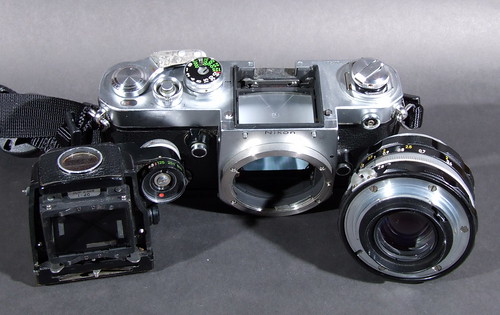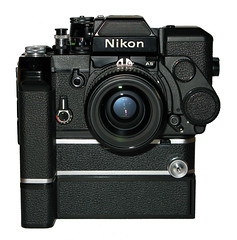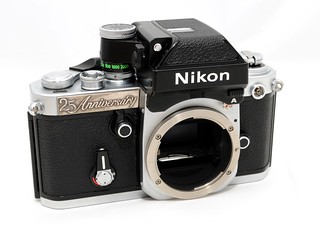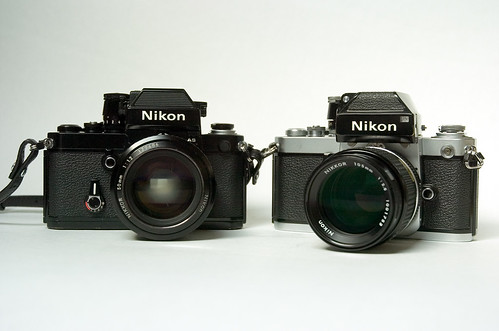Difference between revisions of "Nikon F2"
m (→Literature and manuals: Removed link to kyphoto - website closed.) |
|||
| Line 10: | Line 10: | ||
The Nikon F2 is a professional, mechanical shutter [[SLR]] system introduced in 1971 by [[Nikon]] using [[Nikon F mount]] for interchangeable lenses, it is the successor of successful [[Nikon F]]. Instead of an upgrade of [[Nikon F]] it is a completely new body only sharing with its predecessor the lenses, some accessories and the philosophy. | The Nikon F2 is a professional, mechanical shutter [[SLR]] system introduced in 1971 by [[Nikon]] using [[Nikon F mount]] for interchangeable lenses, it is the successor of successful [[Nikon F]]. Instead of an upgrade of [[Nikon F]] it is a completely new body only sharing with its predecessor the lenses, some accessories and the philosophy. | ||
| − | |||
| − | |||
| − | |||
| − | |||
| − | |||
| − | |||
| − | |||
| − | |||
Though very different internally, the F2 was made as ergonomically identical to the original F as possible. Even the weight of the body with the initial DP-1 finder was kept within an ounce of the weight of the departing F with an FTN finder. But the improvements were extensive: | Though very different internally, the F2 was made as ergonomically identical to the original F as possible. Even the weight of the body with the initial DP-1 finder was kept within an ounce of the weight of the departing F with an FTN finder. But the improvements were extensive: | ||
| Line 28: | Line 20: | ||
* Rewind crank with a 6mm raised position for easier manual film rewinding | * Rewind crank with a 6mm raised position for easier manual film rewinding | ||
* Removable hinged back | * Removable hinged back | ||
| + | |||
| + | ==Description== | ||
| + | |||
| + | The F2 is an all-mechanical camera body, though it has a body compartment for either 2 lr44-equivalent 1.5v cells, or a double cell of equivalent dimensions and output. These batteries are not used by the body--two contacts on either side of the finder mount conduct power up into any metered finder that is attached. When there is no finder or an unmetered finder, the batteries are not drained, and no power flows when the film advanced lever is in its fully home position. | ||
| + | |||
| + | In most ways the design is that of a normal professional SLR: most of the controls are in their most conventional places, and its ergonomics are common-sense--the shutter release is positioned for the right index finger, the stop-down control for the middle finger, the advance lever for the thumb. | ||
| + | |||
| + | The camera has a number of fairly unique controls, however: the back release is on the bottom--it is a folding key like the bottom release on a Leica; the shutter release does not have a socket for a standard cable release, having instead an exterior socket like on many Nikons; finally, the ring around the shutter release has two settings whose meanings are not immediately apparent to a newcomer. These are a lock, as on many professional cameras, which blocks the shutter release, and a "time" setting which allows extremely long timed exposures. More on this below. | ||
| + | |||
| + | ==Shutter== | ||
| + | |||
| + | The shutter, in some ways, is a much more advanced, 1970's version of a Leica III-style shutter--this is to say, it has two speed selectors for two different speed ranges. On the Leica III, speeds below 1/50th were selected on a second dial, which introduced a second, slower timer into the mechanism. | ||
| + | |||
| + | On the Nikon, the shutter goes up to 1/2000th, an impressive top speed for the time, and the main dial goes all the way down to 1 second. For longer exposures, the ''self timer'' becomes the second shutter timer. This is accomplished by setting the main shutter dial to B, setting the ring around the shutter release to "T" and selecting a speed with the speed indicator on the self timer. When the shutter is released, the self timer will become connected to the shutter release mechanism and hold the shutter open while it runs down. This gives speeds from 2 seconds to 10 seconds, though over time, without service, the timer will naturally slow down and these speeds will become inaccurate, much as the slowest speeds on the normal dial will. | ||
| + | |||
| + | The shutter curtains are rubberized foil with a honey-comb pattern of oblong shapes embossed on it, not the rubberized cloth more common in focal plane shutters of this era. | ||
| + | |||
| + | The film advance lever includes a power switch that turns on and off the power supply to any metered finder that is mounted. When it is pulled out slightly past a light catch, a red dot on top of the camera is exposed and the meter receives power through the contacts. | ||
| + | |||
| + | ==Viewfinder== | ||
| + | |||
| + | As a true system camera, both the viewfinder and the focusing screen are separately interchangeable, and the camera can be used in waist-level mode without a viewfinder. The viewfinder is released by a recessed button on the top left rear of the camera, which is best pressed by a penny or a dime. Most finders for this camera have their own latching mechanism, which must also be released to remove them. | ||
| + | |||
| + | The finders fall into two varieties: metered and un-metered. Most unmetered viewfinders were non-pentaprism units for specialty applications--there was a waist-level viewing hood, an eye-level vertical "chimney" finder with high magnification for critical focusing, as well as a similar one with a 90 degree prism and a large pentaprism "action finder" with a large window and high eye-relief, for applications like sports photography. There is also the unmetered DE-1 prism, which is ostensibly the standard finder for the F2, but which is rare in practice as the various versions packaged with metered prisms well outsold the Standard F2. The DE-1 and most other prism finders have a contact which connects to various Nikon flashes, in order to light a small light in the eyepiece when the flash is charged to fire. | ||
| + | |||
| + | There are different versions of the F2 depending on the finder attached to the body. The body comes in chrome or in black. The plain prism finder DE-1 also comes in chrome or in black. All other finders are in black only. | ||
| + | |||
| + | * '''Standard F2''' has the plain prism finder DE-1 | ||
| + | * '''F2 photomic''' has the finder DP-1; uses semi-auto indexing so that the ''twist-twist'' must be done when mounting a lens. The prong on the lens communicates the aperture setting to the finder. | ||
| + | * '''F2S''' has the finder DP-2; DP-2 is similar to DP-1 except it uses diodes instead of needles to show over- or under-exposure. | ||
| + | * '''F2SB''' has the finder DP-3; DP-3 is an improvement of DP-2 using silicon-blue cells. | ||
| + | * '''F2A''' has the finder DP-11, which is the auto-indexing version of DP-1. An auto-indexing finder does not need the lens prong to indicate the aperture setting. | ||
| + | * '''F2AS''' has the finder DP-12, which is the auto-indexing version of DP-3. | ||
| + | * '''F2T''' or '''F2 Titan''' is titanium-clad. | ||
| + | |||
{{br}} | {{br}} | ||
{{Flickr_image | {{Flickr_image | ||
Revision as of 02:24, 26 May 2020

|
| Nikon F2 image by Süleyman Demir (Image rights) |
The Nikon F2 is a professional, mechanical shutter SLR system introduced in 1971 by Nikon using Nikon F mount for interchangeable lenses, it is the successor of successful Nikon F. Instead of an upgrade of Nikon F it is a completely new body only sharing with its predecessor the lenses, some accessories and the philosophy.
Though very different internally, the F2 was made as ergonomically identical to the original F as possible. Even the weight of the body with the initial DP-1 finder was kept within an ounce of the weight of the departing F with an FTN finder. But the improvements were extensive:
- Extended shutter speed range of 10s to 1/2000 and 1/80 flash sync
- ASA 6 to 6400 with initial DP-1 head
- Larger reflex mirror to minimize viewfinder vignetting with some lenses
- Shorter 120 degree stroke, and integrated On/off switch in film advance lever
- Rounded contour body for better ergonomics
- Rewind crank with a 6mm raised position for easier manual film rewinding
- Removable hinged back
Description
The F2 is an all-mechanical camera body, though it has a body compartment for either 2 lr44-equivalent 1.5v cells, or a double cell of equivalent dimensions and output. These batteries are not used by the body--two contacts on either side of the finder mount conduct power up into any metered finder that is attached. When there is no finder or an unmetered finder, the batteries are not drained, and no power flows when the film advanced lever is in its fully home position.
In most ways the design is that of a normal professional SLR: most of the controls are in their most conventional places, and its ergonomics are common-sense--the shutter release is positioned for the right index finger, the stop-down control for the middle finger, the advance lever for the thumb.
The camera has a number of fairly unique controls, however: the back release is on the bottom--it is a folding key like the bottom release on a Leica; the shutter release does not have a socket for a standard cable release, having instead an exterior socket like on many Nikons; finally, the ring around the shutter release has two settings whose meanings are not immediately apparent to a newcomer. These are a lock, as on many professional cameras, which blocks the shutter release, and a "time" setting which allows extremely long timed exposures. More on this below.
Shutter
The shutter, in some ways, is a much more advanced, 1970's version of a Leica III-style shutter--this is to say, it has two speed selectors for two different speed ranges. On the Leica III, speeds below 1/50th were selected on a second dial, which introduced a second, slower timer into the mechanism.
On the Nikon, the shutter goes up to 1/2000th, an impressive top speed for the time, and the main dial goes all the way down to 1 second. For longer exposures, the self timer becomes the second shutter timer. This is accomplished by setting the main shutter dial to B, setting the ring around the shutter release to "T" and selecting a speed with the speed indicator on the self timer. When the shutter is released, the self timer will become connected to the shutter release mechanism and hold the shutter open while it runs down. This gives speeds from 2 seconds to 10 seconds, though over time, without service, the timer will naturally slow down and these speeds will become inaccurate, much as the slowest speeds on the normal dial will.
The shutter curtains are rubberized foil with a honey-comb pattern of oblong shapes embossed on it, not the rubberized cloth more common in focal plane shutters of this era.
The film advance lever includes a power switch that turns on and off the power supply to any metered finder that is mounted. When it is pulled out slightly past a light catch, a red dot on top of the camera is exposed and the meter receives power through the contacts.
Viewfinder
As a true system camera, both the viewfinder and the focusing screen are separately interchangeable, and the camera can be used in waist-level mode without a viewfinder. The viewfinder is released by a recessed button on the top left rear of the camera, which is best pressed by a penny or a dime. Most finders for this camera have their own latching mechanism, which must also be released to remove them.
The finders fall into two varieties: metered and un-metered. Most unmetered viewfinders were non-pentaprism units for specialty applications--there was a waist-level viewing hood, an eye-level vertical "chimney" finder with high magnification for critical focusing, as well as a similar one with a 90 degree prism and a large pentaprism "action finder" with a large window and high eye-relief, for applications like sports photography. There is also the unmetered DE-1 prism, which is ostensibly the standard finder for the F2, but which is rare in practice as the various versions packaged with metered prisms well outsold the Standard F2. The DE-1 and most other prism finders have a contact which connects to various Nikon flashes, in order to light a small light in the eyepiece when the flash is charged to fire.
There are different versions of the F2 depending on the finder attached to the body. The body comes in chrome or in black. The plain prism finder DE-1 also comes in chrome or in black. All other finders are in black only.
- Standard F2 has the plain prism finder DE-1
- F2 photomic has the finder DP-1; uses semi-auto indexing so that the twist-twist must be done when mounting a lens. The prong on the lens communicates the aperture setting to the finder.
- F2S has the finder DP-2; DP-2 is similar to DP-1 except it uses diodes instead of needles to show over- or under-exposure.
- F2SB has the finder DP-3; DP-3 is an improvement of DP-2 using silicon-blue cells.
- F2A has the finder DP-11, which is the auto-indexing version of DP-1. An auto-indexing finder does not need the lens prong to indicate the aperture setting.
- F2AS has the finder DP-12, which is the auto-indexing version of DP-3.
- F2T or F2 Titan is titanium-clad.

|
| Nikon F2 Titan with AS-Finder, Motor Drive MD-2, Battery-pack MB-1 and DS-12 EE Aperture Control Unit image by wolf4max (Image rights) |

|
| Nikon F2A, 25th Anniversary image by KEH Camera (Image rights) |
General links

|
| Nikon F2AS versus F2 Photomic image by Paul Moore (Image rights) |
In English:
- Legendary Nikons: Nikon F2, at Nikon's History & Technology site
- Debut of Nikon F2, at Nikon's Camera Chronicle
- Nikon F Collection & Typology (includes F2 bodies and accessories), by Richard de Stoutz
- Specialist Nikon F2 Repair & Restore Services by Sover Wong
- Nikon F2 Photomic (1971) with MD-2 motor drive by luis triguez
In Spanish:
- Nikon F2, by Daniel Jiménez, at Del infinito al plano focal
- Nikon F2 Photomic AS in the website of Hugo Rodriguez
In French:
- Nikon F2 on www.collection-appareils.fr by Sylvain Halgand
Literature and manuals
- Nikon F2 instruction manual - English at at M.Butkus' www.orphancameras.com
| Nikon 35mm SLR Cameras | |
|---|---|
| Nikkorex F | Nikon EL2 | Nikon EM | Nikon F | Nikon F2 | Nikon F3 | Nikon F4 | Nikon F5 | Nikon F6 | Nikon F50 | Nikon F55 | Nikon F60 | Nikon F65 | Nikon F70 | Nikon F75 | Nikon F80 | Nikon F90 | Nikon F90X | Nikon F100 | Nikon F-301 | Nikon F-401 | Nikon F-401S | Nikon F-401X | Nikon F-501 | Nikon F-601 | Nikon F-601M | Nikon F-801 | Nikon F-801s | Nikon FA | Nikon FE | Nikon FE2 | Nikon FE10 | Nikon FG | Nikon FG-20 | Nikon FM | Nikon FM2 | Nikon FM2n | Nikon FM3A | Nikon FM10 | |
| Nikomat / Nikkormat | |
| EL | EL2 | ELW | FS | FT | FT2 | FT3 | FTN | |